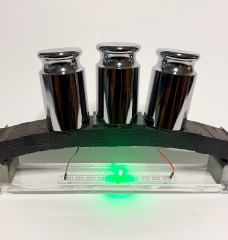
To design buildings that can withstand the largest of storms, Kostas Keremidis, a PhD candidate at the MIT Concrete Sustainability Hub, is using research at the smallest scale — that of the atom.
His approach, which derives partially from materials science, models a building as a collection of points that interact through forces like those found at the atomic scale.
“When you look at a building, it is actually a series of connections between columns, windows, doors, and so on,” says Keremidis. “Our new framework looks at how different building components connect together to form a building like atoms form a molecule — similar forces hold them together, both at the atomic and building scale.” The framework is called molecular dynamics-based structural modeling.
Eventually, Keremidis hopes it will provide developers and builders with a new way to readily predict building damage from disasters like hurricanes and earthquakes.
Making models
But before he can predict building damage, Keremidis must first assemble a model.
He begins by taking a building and dividing its respective elements into nodes, or "atoms." This is a standard procedure called "discretization," whereby a building is divided into different points. Then he gives each "atom" different properties according to its material. For example, the weight of each "atom" may depend on if it’s part of a floor, a door, a window, and so on. After modeling them, he defines their bonds.
The first type of bond between points in a building model is called an axial bond. These describe how elements deform under a load in the direction of their span — in other words, they model how a column shrinks and then rebounds under a load, like a spring.
The second type of connection is that of the angular bonds, which represent how elements like a beam bend in the lateral direction. Keremidis uses these vertical and lateral interactions to model the deformation and breaking of different building elements. Breaking occurs when these bonds deform too much, just like in real structures.
To see how one of his buildings will fare under conditions like storms or earthquakes, Keremidis must thoroughly test these assembled atoms and their bonds under numerous simulations.
“Once I have my model and my building, I then run around 10,000 simulations,” explains Keremidis. “I can assign 10,000 different loads to one element or building, or I can also assign that element 10,000 different properties.”
For him to assess the results of these simulated conditions or properties, Keremidis returns to the bonds. “When they deform during a simulation, these bonds will try to bring the building back to its original position,” he notes. “But they may also get damaged, too. This is how we model damage — we count how many bonds are destroyed and where.”
The damage is in the details
The model’s innovations actually lie in its damage prediction.
Traditionally, engineers have used a method called finite element analysis to model building damage. Like MIT’s approach, it also breaks down a building into component parts. But it is generally a time-consuming technique that is set up around the elasticity of elements. This means that it can model only small deformations in a building, rather than large-scale inelastic deformations, like fracture, that frequently occur under hurricane loads.
An added benefit of his molecular dynamics model is that Keremidis can explore “different materials, different structural properties, and different building geometries” by playing with the layout and nature of atoms and their bonds. This means that molecular dynamics can potentially model any element of a building, and more quickly, too.
By scaling this approach beyond individual buildings, molecular dynamics could also better inform city, state, and even federal hazard-mitigation efforts.
For hazard mitigation, cities currently rely on a model by the Federal Emergency Management Agency (FEMA) called HAZUS. It takes historical weather data and a dozen standard building models to predict the damage that a community might experience during a hazard.
While useful, HAZUS is not ideal. It offers around only a dozen standardized building types and provides qualitative, rather than quantitative, results.
The MIT model, however, will allow stakeholders to go into finer detail. “With FEMA’s HAZUS, the current level of categorization is too coarse. Instead, we should have 50 or 60 building types,” says Keremidis. “Our model will allow us to collect and model this wider range of buildings types.”
Since it measures damage by counting the broken bonds between atoms, a molecular dynamics approach will also more easily quantify the damage that hazards like windstorms or earthquakes can inflict on a community. Such a quantifiable understanding of hazard damage should lead to more accurate estimations of mitigation costs and recovery.
According to the U.S. Congressional Budget Office, wind storms currently cause $28 billion in damage annually. By 2075, they will cause $38 billion, due to climate change and coastal development.
With a molecular dynamics approach, developers and government agencies will have one more tool to predict and mitigate these damages.
The MIT Concrete Sustainability Hub is a team of researchers from several departments across MIT working on concrete and infrastructure science, engineering, and economics. Its research is supported by the Portland Cement Association and the Ready Mixed Concrete Research and Education Foundation.






